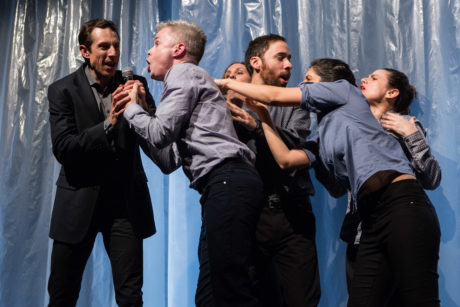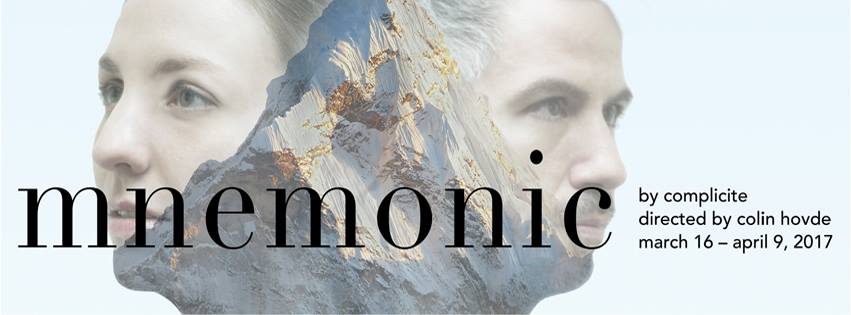Just now when the world is wracked with wave upon wave of ethnic animus—just now when our country has succumbed to xenophobia not seen on these shores for decades—there comes a work of theatrical art so richly imagined and so radically transformational that it causes a healing hush to fall over the audience.

This happens early on in the show as we are treated by the actor Carlos Saldaña to a sort of Ted Talk about origins and memory. Standing before a frosted plastic curtain and addressing us on a hand mic, he amiably gains our trust such that we oblige him when he asks us to put on the blindfold that we were handed as we entered the theater.
Slowly in our sightlessness the actor then coaches us into a visualization that becomes a startling perception: the recognition that the further back we trace our origins, the more we share the same cellular memory as members of the same species. We literally are all related to one another and “the more chaotic our inter-relationships.” No one is ever other. We are linked in our origins, in our migrating genealogies, in “the pattern of our ancestry.”
The gift of that indelible moment sets in motion the unforgettable play named Mnemonic.
I first saw Mnemonic some fifteen years ago when Complicité, the British theater company that devised it under the direction of Simon McBurney, brought it to New York. The moment I just described has never left me, as I suspect it will not anyone who sees Theater Alliance’s absorbing production now.
What happens next works in the head in ways only obliquely related to what happens on stage. That is the particular genius of this theater piece. It has two interweaving story lines that are only tangentially related. They’re really more like complementary metaphors than two intertwined plots, two parts that make a whole other whole.
In one of the story lines, Saldaña becomes Virgil, a man whose partner Alice abruptly left him nine months ago. He is bereft. Eventually they make long-distance cell phone contact and she tells him she’s on a quest in Eastern Europe to find traces of the father whose identity she only recently learned. Virgil’s and Alice’s story is a tale of love lost and not quite restored; a saga of roots lost and not quite found. It’s a human-interest narrative that by itself could fill a play with engaging relationship drama. And Teresa Spencer is terrific in the role of Alice. Her presence and assertion of self make an enormous contribution to the veracity of what transpires.

The other story line is about a scientific discovery in the Austrian Alps: the frozen body of the so-called Iceman (represented by Saldaña nude), who lived some 5,000 years ago. As the Iceman’s clothing, artifacts, and corpse are analyzed to reveal details about who he was, what he was doing there, how he lived and died, Alice is simultaneously learning details about who her father was, what he was doing where she sought him, and how he lived and died. The effect of taking in these two biographical dossiers in overlapping stage time but vastly distant in geography and generation makes for an extraordinary experience in theater. Mnemonic is unique in that it is everyday story telling, yet it seems more like found mythology. Almost mystically the stage action of Mnemonic comes to stand for our personal and collective understanding that we stem from a common family tree.
Saldaña and Spencer are joined by a gifted and versatile ensemble who play multiple supporting roles: Jon Reynolds, Vanita Kalra, Elena Day, Jonathan David Martin, and Michael Burgos. Besides their physical and mimetic agility they prove adept at delivering lines in multiple languages. This has the marvelous effect of underscoring what is truly global in the meaning of Mnemonic.
Director Colin Hovde has conceived a production so faithful to the magic in the material one cannot but wonder wide-eyed how it was done. He is ably aided by Movement Director Dody DiSanto, who creates vivid tableaux. And Scenic Designer Tony Cisek turns Anacostia Playhouse into a proscenium stage full of surprises, notably set pieces spun around between scenes by the actors in a whirling blur.
Costume Designer Danielle Preston locates the actors nicely in the here and now, even as the show’s scope sweeps us elsewhere and long ago. And Sound Designer Matthew M. Nelson creates a realistic aural world even as the stage world goes surreal, as it does often thanks to dazzling work by Lighting Designer William K. D’Eugenio and Projections Designer Patrick W. Lord. Special props to Properties Artisan Alex Vernon, who turns an ordinary item of furniture into an astonishing creature.
Theater Alliance’s Mnemonic is not only thrilling theater. It is a stirring and uplifting parable of our profound kinship. And in these troubling times for our disunited extended family, Mnemonic is welcome as rain during a drought.
Running Time: One hour and 40 minutes, with no intermission.
Mnemonic plays through April 9, 2017, at Theater Alliance, performing at The Anacostia Playhouse – 2020 Shannon Place SE, in Washington, DC. For tickets, purchase them online.






There was a prop in this show designed and built by the brilliant Alex Vernon that was absolutely spectacular on stage but I could not say much about it in my review because that would have been a major spoiler. Now that the show has closed, the story can be told. This is reason No. 3406897 why the magic of live theater beats movie FX for me any day. Holly Hassett Colin Stanley Hovde Theater Alliance
https://youtu.be/w6pYau48Dq0